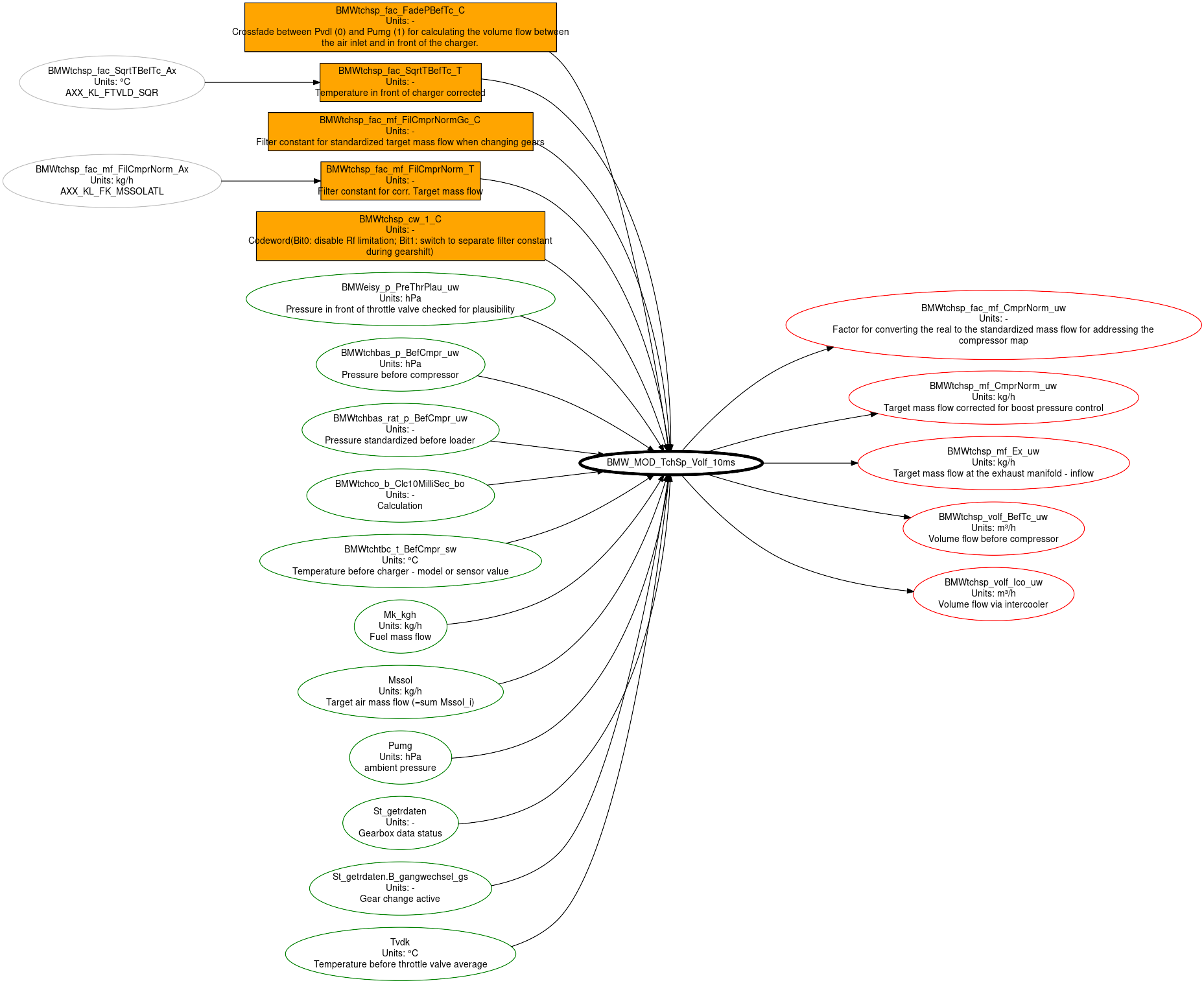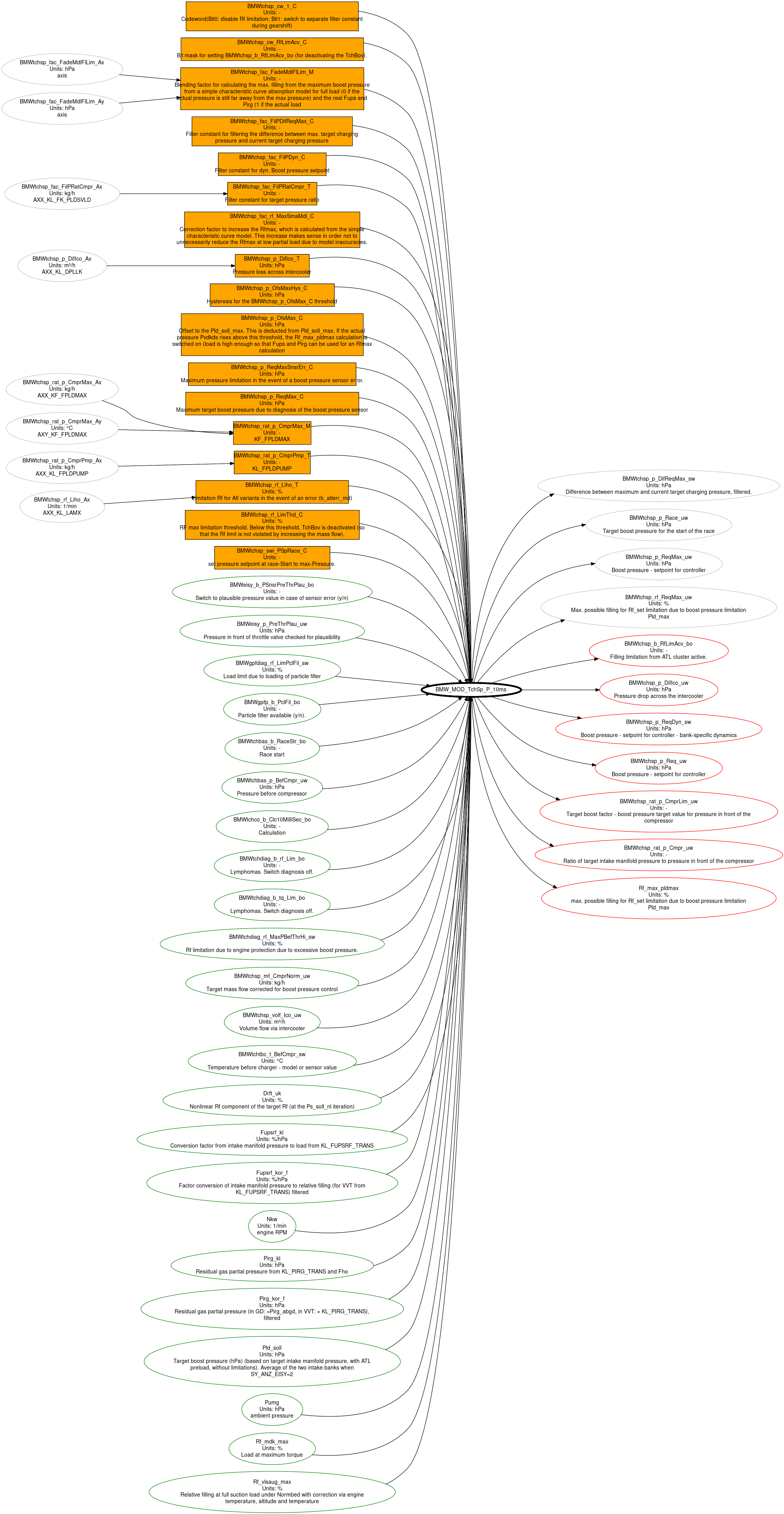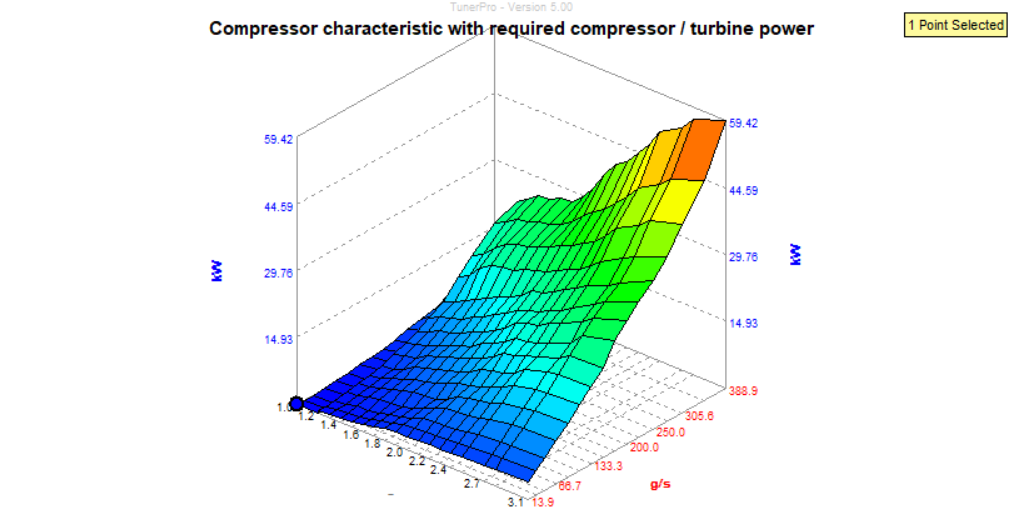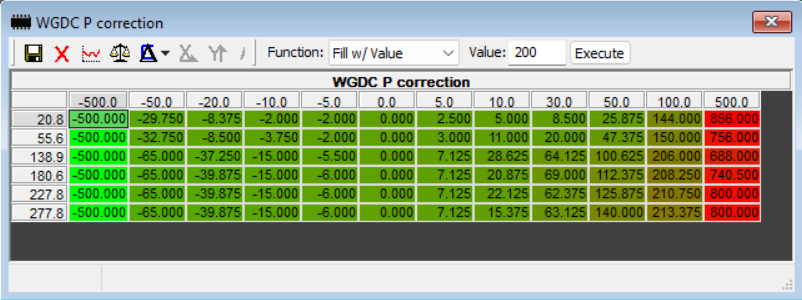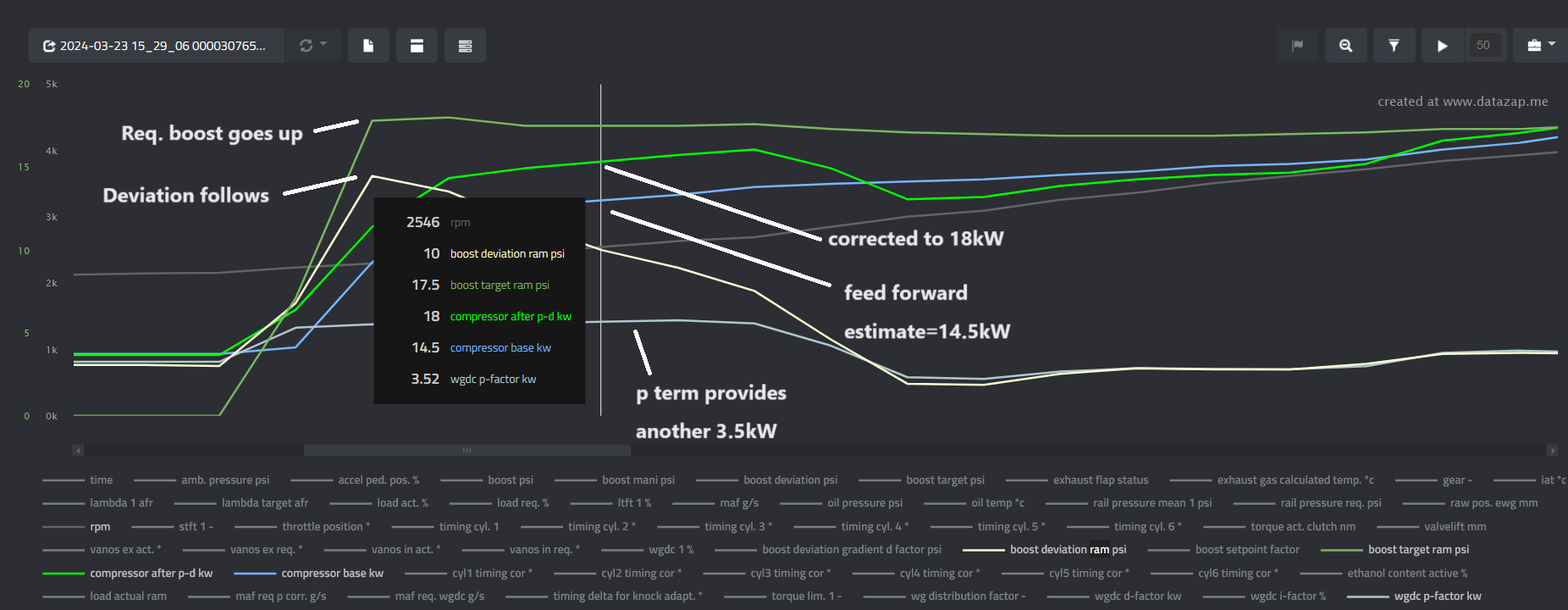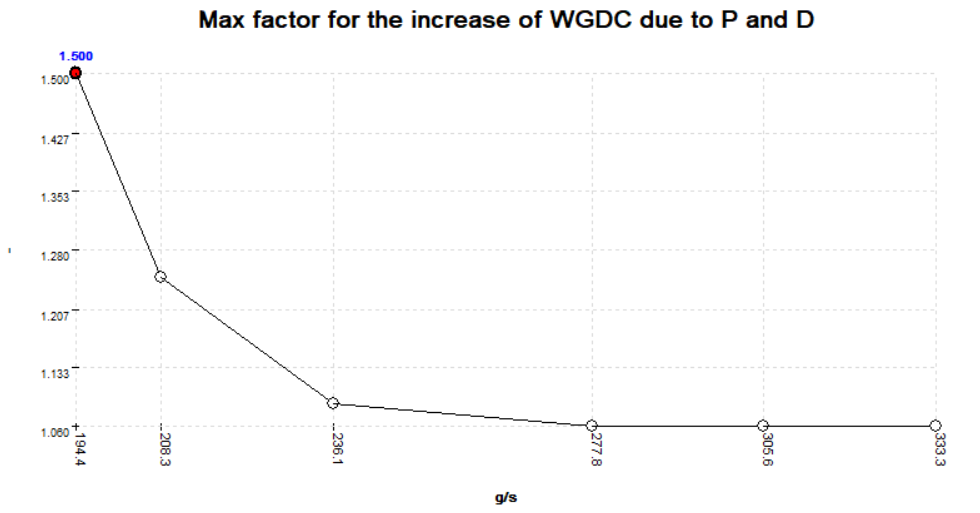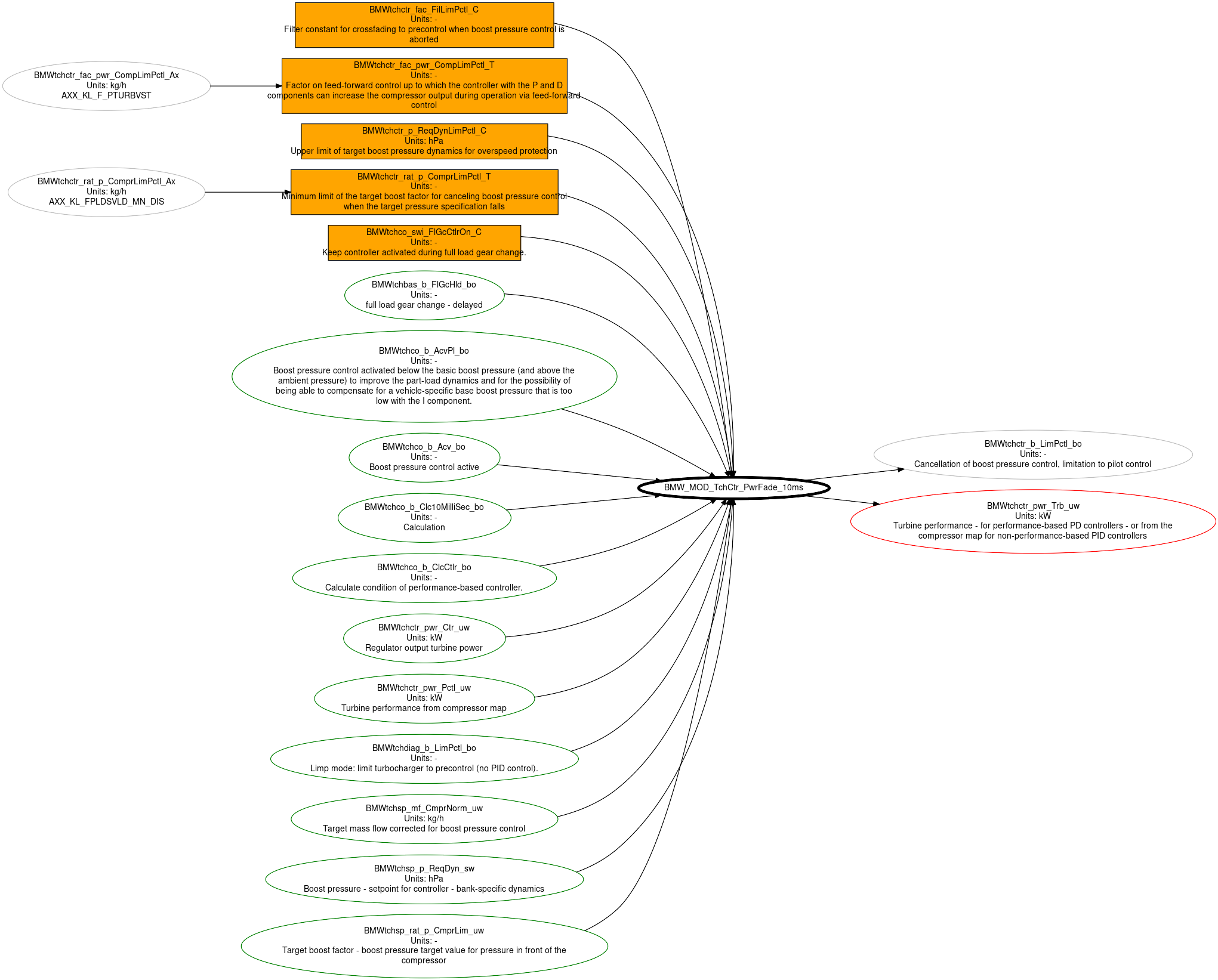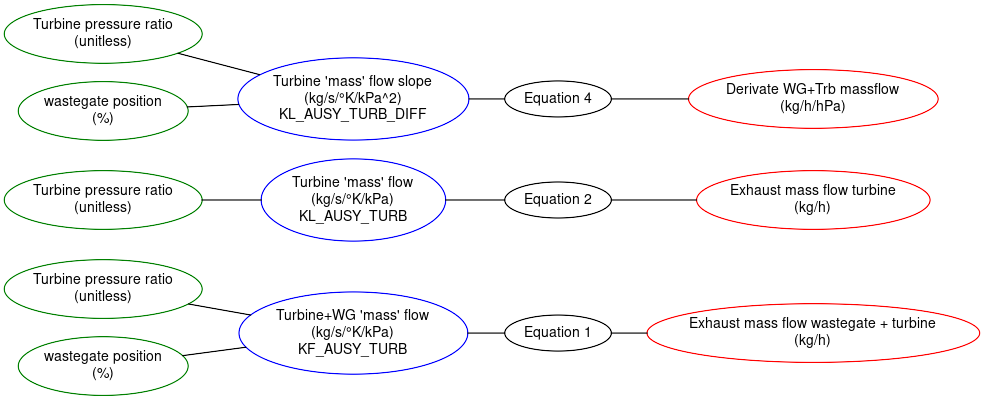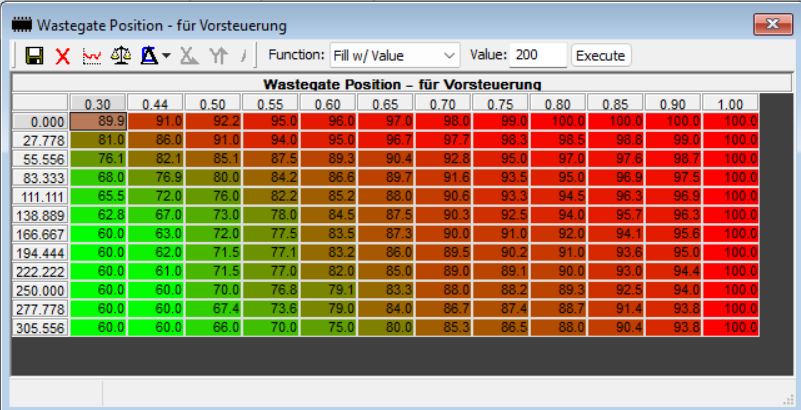Boost Control
Here we talk generally about how the B58 controls the turbo and more specifically about the maps you might need to recalibrate when changing from the stock turbo.
Boost control has several steps:
- Figure out the boost target
- Convert the boost target and error into power at the turbine wheel (i.e. how hard and fast the turbo should be spinning).
- Work out the power inherent in the exhaust flow and, thus, how much of that should be ejected through the wastegate.
- Work out the wastegate position to achieve that.
We note that we are controlling a single variable, the boost, but we have two parameters: the turbine power and the wastegate position with which to affect it. In effect, the turbine power is arbitrary. This makes the problem underconstrained. We will gain an understanding of the turbo control then look at ways to pin this down.
!!! WORK IN PROGRESS !!!
Boost setpoint
Here, the DME runs through conversions of temperature and pressure quantities to arrive at the target MAF and target boost pressure for the turbo. It also figures out the deviation of the current boost pressure from the target and the target exhaust massflow by summing the air mass flow and the fuel mass flow.
There are a number of limits applied...
Target massflow and pressure are both lowpass filtered using tables BMWtchsp_fac_FilPRatCmpr_T and BMWtchsp_fac_mf_FilCmprNorm_T. These contain massflow-dependent constant and are configured for stock-like flows of upto 1100 kg/h (about 305 g/s). Consider adjusting for larger turbos. For example:
Name: BMWtchsp_fac_FilPRatCmpr_T
Description: Filter constant for target pressure ratio
Unit info: kg/h --> -
Axis: BMWtchsp_fac_FilPRatCmpr_Ax
Base:
200.000 300.000 900.000 1100.000 0.120 0.120 0.070 0.030
Modified:
200.000 300.000 900.000 1800.000 0.120 0.120 0.070 0.030
Name: BMWtchsp_fac_mf_FilCmprNorm_T
Description: Filter constant for corr. Target mass flow
Unit info: kg/h --> -
Base:
200.000 300.000 1100.000 1120.000 0.120 0.100 0.100 0.020
Modified:
200.000 300.000 1100.000 1800.000 0.120 0.100 0.100 0.020
The following limit is applied to to the charge pipe pressure sensor:
Name: BMWtchsp_p_ReqMax_C
Description: Maximum target boost pressure due to diagnosis of the boost pressure sensor
Units: hPa
Base:
2500.000
Modified:
3000.000
Maps feeding into the volume flow calculation are shown in orange below:
Maps feeding into the pressure calculation are shown below:
Power calculation (TchCtr_Pwr)
The first job of the boost controller is to work out how fast and hard is should be spinning the turbo to meet the required boost pressure. As such, (required) boost pressure quantities are converted into (required) power at the turbine wheel (in kW). Likewise boost errors are converted into power errors.
We can understand turbine power in terms of torque x rpm just as we can for engine power. As the boost pressure goes up, the air resistance on the compressor wheel also goes up so it needs more torque to keep turning at the same speed. As the engine speed rises and the airflow picks up, we can picture the compressor chasing the air and so it will have to rotate faster to create the same boost. For this reason, the compressor characteristic (BMWtchctr_pwr_Pctl_M) will tend to rise with pressure and with RPM:
Note that the boost axis does not have any units because the boost pressure in the chargepipe is divided by the pressure before the turbo. This value is often called boost presure ratio.
The pressure before the turbo is ambient pressure minus any pressure drop across the air filter. The more air pulled through the filter, the more that filter gets in the way and hence this pressure drop becomes higher as airflow increases.
Feed-forward compressor map
Initially, the DME creates a good guess at the required turbine power through a feed-forward map, called the compressor characteristic (BMWtchctr_pwr_Pctl_M). This outputs a feed-forward compressor power.
This is fairly straightforward to understand: the map represents the turbo's power at various airflow and pressure-ratio values. The DME reads these off, corrects for temperature and we're done.
Note that with different and possibly bigger turbos than stock
- They will flow more air so the MAF axis might require scaling up. A Pure800 would max out at about 500g/s for example.
- The power values might be lower not higher. In other words, if the turbo is operating more efficiently, it will generate the same MAF at lower power.
P error term
The DME then calculates a proportional error term:
This is a more subtle scenario.
Firstly we have the P-Factor (MHD's name) which is based on airflow and pressure-ratio (same as the compressor characteristic). Note that this does not depend on the boost error. It is more a property of the turbo as a system in the sense of how aggressively it responds. Note in particular
- When there is airflow through the turbo (i.e. it is spooled up), the turbo is responsive and P-Factor will be higher.
- When boost rises, the turbo has to work harder (to cut through the air, so to speak), it becomes less responsive and P-Factor will be lower.
The degree to which these effects occur depend on the turbo.
Then we have the P correction. Note that the inputs here are turbine massflow and boost error.
We note the following:
- This is where the error is factored in. When the error is zero, the value will be zero so as to cancel the P term in the PID control.
- boost error = (target - actual) so underboost is a +ve error (which is confusing because we intuively think of under as meaning less, but it is the other way around here).
- the correction provides a weighting to the boost error according to how far out of step it is with what's required in the exhaust.
- If we need a lot of exhaust flow and we are underboosting, the correction table will increase the p factor to hurry the turbo into meeting the demand.
- If we need not so much exhaust flow and are underboosting, the correction table will slow down the p factor.
- There is an additional spool mode table, however, this is often unused. The DME has a notion of spooling and an associated spooling factor which it determines from the boost error in the sense that, if we require a lot of boost but the actual boost is low, then the turbo must be spooling and so the spool factor that will be close to 1. Then, the DME can interpolate between the normal p-correction table and the spool table according to a second blending factor which it gets from a table (BMWtchctr_fac_FadeDyn_M). In practice this blending factor is zero, meaning only the normal table is used. To our mind, this is too much complexity but we mention it for anyone wanting to introduce a few more variables.
We can see this process in action in the following log:
Note that the names in the log are confusing. The 'p-factor' here is the final p term (and not the turbo gain property from the P-factor table).
D error term
Here, MHD's naming is to use D-Factor as the table which accounts for the error and D-Correction is now the power-based property-of-the-system factor.
Note that the gradient of the error is itself a pressure quantity (in hPa). As such, we think about it as the difference between successive boost error samples. (In other words, if gradient is rise/run then the rise the difference in the boost error samples but we do not bother with the run because it is always the same value.
Generally, the D-Factor values are small. This means we can worry less about them. For example, on the stock tune, with large underboost of 400 hPa (6psi) and maxed out gradient, the maximum possible D term would only adds 1.5kW to the compressor target.
| Error (hPa) | Error Gradient (hPa) | Compr Power (kW) | D term (kW) |
|---|---|---|---|
| 400 | 30 | 21 | 1.62 |
| 400 | 30 | 31 | 1.62 |
| 400 | 30 | 41 | 1.62 |
| 400 | 30 | 51 | 1.62 |
| 360 | 30 | 21 | 1.566 |
| ... | ... | ... | ... |
Generally, on logs, we want to see the feed-forward compressor map get as close to target as possible (in other words, the feed-forward compressor power and the compressor power after PD correction are the same to within a few percent). The caveat, at this point, is that we do not yet know whether the boost errors being fed back are caused by errors in our compressor map or errors in our wastegate position calculation. Let's move on to look at that problem.
Required turbine power
Once the feed forward and error terms have been calculated, the DME adds them up to arrive at a final value for the turbine power. This will be fed into the wastegate position control (see next section).
Limiting PID control (TchCtr_PwrFade)
Disabling PID control
In some cases, the DME will discard the PID output in favour of the value from the compressor map. This happens when:
- the boost target drops below the actual boost by a value controlled by BMWtchco_p_HysAcv_C. Stock, this is 15MPa (0.2 psi). This can be interpreted as a hysteresis value. If the car is asking for more boost than it has currently, the PID will stay enabled to meet it. If the target drops, the PID will not be disabled unless the target drops sufficiently. This prevents jittery switching off of boost control.
- changing gear, when stationary, when heating the cat, in limp mode, in launch mode, in eco mode, when the car wants to open the wastegate for sounds like braps.
Capping PID control
Optionally, the DME can be setup to cap the level to which the PID controller can increase the power from the compressor map. This is primarily to protect the turbo from overspeed conditions due to (experimental) PID output.
The cap is itself controlled by a map called BMWtchctr_fac_pwr_CompLimPctl_T or (Max factor for the increase of WGDC due to P and D in MHD's XDF files).
The capping calculation applied is . If, for example, the factor is 1.08 (i.e 8%), and the output of the PID is then 10% more than the compressor map output then the DME will take the value from the compressor map.
Notice that the factor is MAF dependent and
- values at low to medium MAF allow the PID controller to raise the power target substantially (50-20%).
- becomes restrictive at higher MAF (down to 6%).
- the breakpoints on this curve are scaled for the mass flow range of the stock turbo. Rescaling the breakpoints might be needed for different turbos.
Finally, the capping only applies to target boost pressure below a certain maximum and target pressure ratios above a certain minimum:
- The boost maximum limit is BMWtchctr_p_ReqDynLimPctl_C
- And pressure ratio minimum limit is BMWtchctr_rat_p_ComprLimPctl_T (MAF dependent pressure ratios)
This provides a windowing mechanism for the PID cap.
On the stock tune, this capping path is disabled (because the upper limit, BMWtchctr_p_ReqDynLimPctl_C, is set to 0hPa and the pressure ratio minium to 6) so the capping condition is never true. Nonetheless, if you are changing the PID settings, this path is available for overspeed protection.
The diagram below show the blackbox view of the entire function. The crucial thing is the output: this is power target that gets handed over to the turbine side, which will then be met with wastegate position.
Turbine mass flow calculation
There are calculations to determine the turbine and wastegate mass flows.
This introduces some new tables:
- KF_AUSY_TURB -- this is the massflow table for the turbine + wastegate combined. This depends on both the pressure ratio across the turbine and the wastegate position (because there will be more flow if the wastegate is open).
- KL_AUSY_TURB -- this is the massflow curve for the turbine. This only depends on the pressure ratio (because the hole has a fixed size).
- KL_AUSY_TURB_DIFF -- this is a table of the slope of KL_AUSY_TURB.
- KL_TABG2TABG_WZINV -- this contains pre-calculated values for . It is scaled out to temps of 1400K (1125 C). (We will consider exhaust temps and pressures separately).
Stock, the massflow tables are scaled out to a pressure ratio of 2.8 so you should consider extending this for custom turbos and downpipes. (There will be higher pressure in the manifold and lower pressure after the turbo because less restrictive downpipes).
...1
...2
...3
...4
where
- is the output of map KF_AUSY_TURB (turbine plus wastegate flow map)
- is the output of curve KL_AUSY_TURB (the turbine flow curve)
- are the massflows of turbo, wastegate and turbine respectively (BMW names: Msturb, Mswg, Msturbine).
- p_{ak} is the exhaust manifold pressure (in hPa)
- t_{ab} is the exhaust gas temperature (in Kelvin)
- is the the output of map KF_AUSY_TURB_DIFF (the slope of the exhaust flow map).
Target turbine pressure ratio
From the above massflow calculation, the DME knows massflow given pressure ratio. It now turns this question around to ask, given massflow (from MAF and fuel mass), what is the pressure ratio? To do this, it inverts KF_AUSY_TURB.
Because the exhaust massflow here is the target massflow, the corresponding turbine pressure ratio is the target pressure ratio.
The wastegate position is also a variable and it is the quantity we are ultimately trying to figure out. As such, the DME proceeds iteratively, using the current wastegate position to complete its calculation, which will provide an updated position and so on.
Exhaust massflow
Now the DME software incorporates the required turbine power and pressure ratio to obtain a turbine massflow. The flow is as follows:
Note there are two tables that have axes which depend on pressure ratio:
- BMWtchctr_fac_TrbEffIvs_T. This is the so called turbine efficiency. It reflects properties of the turbo (so consider scaling the axis and setting suitable values).
- BMWtchctr_fac_TrbExp_T. Specific temperature change curve. This is a pre-calculated table. A spreadsheet formula to recalculate it with different axis values is =1/(1-(1/X)^((1.395-1)/1.395)) (where X is a reference to the axis value).
Wastegate Position calculation (TchCtr_Pwr2Pos)
At last, the turbine and exhaust massflow requirements are fed into the feedforward wastegate position table:
Note:
- The X axis is the massflow fraction to send down the turbine.
- The stock exhaust flow axis is scaled to 300g/s (1080 kg/h) which is too low for even hybrid turbos.
- 100% wastegate position here corresponds to the wastegate being closed (i.e. all flow through the turbine and none through the wastegate, see below).
